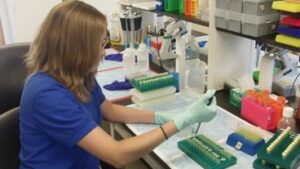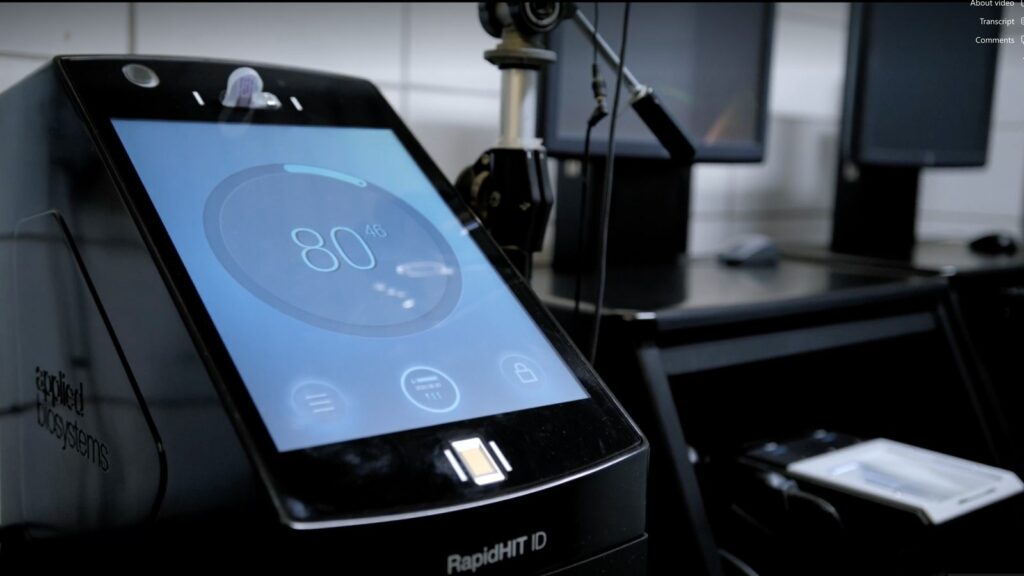The forensic science world expands every year, adding new techniques and new regulations as it goes, and with those advancements comes the printer sized contraption called a ‘Rapid DNA’ instrument that allows for a full DNA profile to be made in under 90 minutes.1 For a normal citizen who does not know much about the complicated process that is called PCR, this may seem normal, but once it’s put into perspective with the current protocols of DNA analysis, this short processing time is nothing but outstanding. This instrument could be used in DNA laboratories, in booking stations, in devastation sites, and quite possibly also in crime scenes, completely changing the way in which investigations are done. Before looking into how crime scene samples could be used with this, it is first important to review what DNA analysis and Rapid DNA is.
The golden standard for human identification in forensic science since the 1990s has been short tandem repeat (STR) analysis. These STR’s are short sequences of DNA that repeat uniquely in each chromosome pair in individuals. This allows for one or two numeric values to be assigned for each gene region in an individual depending on if they are homozygous or heterozygous for that repeat. For example in TH01, a STR loci used by the FBI, the repeat consists of four nucleotides, T-C-A-T. Since each individual gets one chromosome from their mother and one from their father, an individual may have the TCAT repeat 6 times in one and 7 times in the other.2 In a DNA profile report, this would then be cataloged as TH01- 6,7. By itself, it is not that powerful in identifying people, as millions of people may have those two repeat numbers. Once you start adding more STR loci into the calculations though, the power of discrimination greatly increases and allows for the identification of individuals to be incredibly accurate.

To get to this point, there must be a sufficient amount of biological material for this analysis. Samples from crime scenes might range from giant pools of blood or other biological sources to the tiniest drop left behind. In those cases, it is crucial to have a method to replicate that drop to have enough material. PCR, or polymerase chain reaction, is quite possibly the most important technique in forensic science as it allows for that amplification of the source DNA templates, allowing for it to be replicated to make over a billion copies in a relatively short time frame. PCR has three main steps: denaturation, annealing, and elongation. In denaturation, the double stranded DNA is split into single strands after being subjected to temperatures over 90 degrees celsius. After this, the temperature is lowered so that RNA primers, small specific complementary sequences to the DNA template, can bind to the DNA. DNA polymerases then elongate polynucleotide chains, reconstructing the original DNA sequence. This is then repeated for over 30-40 samples to rapidly create new copies of the template DNA. From there, multiple STR’s can be analyzed to create a full DNA profile.3 While this process, called multiplex PCR, only takes about a day to conduct, in a crime lab such as the Texas Department of Public Safety labs, the turn-around time may take weeks due to heavy workloads.4 Comparing those weeks of processing time to the 90 minutes that a Rapid DNA instrument spends, it almost looks like a miracle worker that can save multitudes of DNA analysts’ time and effort.
Rapid DNA analysis is nothing new, it being around for over a decade. It’s a fully automated process that develops a DNA profile without any need for human interpretation. It uses a recreated modern DNA processing workflow with a modified DNA extraction, PCR amplification separation, and data interpretation method.5 Since 2006, the FBI has been looking into how Rapid DNA can change how DNA profiles are entered into their DNA database CODIS, or the Combined DNA Index System. They formed the Rapid DNA initiative and have since partnered with multiple other groups such as the Departments of Defense and Homeland Security to tackle the project. Following the Supreme Court decision that allowed DNA collection practices to be a legitimate booking procedure in the United States in 2013, we soon got the Rapid DNA Act of 2017, letting Rapid DNA instruments be used in booking stations. This would allow for an arrestee’s profile to be uploaded to the CODIS at near real time, leading to possible matches against unsolved crimes while the suspect is still in custody.6 While this seems like an amazing thing, in reality only one state, Louisiana, currently is connected to the state and national databases due to the strict guidelines that one must follow as written by the FBI.7 Some of these guidelines include having automated fingerprint capture, criminal history information integration, and automated qualifying offense integration.8 Another important factor is each state’s DNA collection laws. Texas specifically has a DNA collection act put in place September 1st, 2023, allowing for the collection and upload of DNA profiles of any individual arrested for a felony.9 While other states use Rapid DNA instruments in booking stations, it is only for uploads within their own local databases. One reason for this is due to the fact that some departments may not be using these instruments for their actual intended use, such as entering samples that are not from a known source, i.e. a reference sample. In addition, only two instruments have been approved by the FBI to be used in the booking station setting, those being the ANDE 6C Series G and the RapitHIT ID DNA Booking System from ANDE and Thermo Fisher respectively, two prominent companies when it comes to DNA analysis. These are priced at around $150k each with each sample costing around $100 per analysis.10

In 2019, California used Rapid DNA to quickly identify 33 passengers and a crew mate that died in a boat fire off the coast of Santa Cruz Island. That same year, Rapid DNA was used on bones found on the mountainside in Utah, allowing for the identification of 29-year-old Mark Myres who had gone missing a year prior.11 The ability to rapidly create a DNA profile from unidentified remains is an important aspect of disaster relief. With possibly countless individuals needing to be identified so that their families are notified, this speed is essential. This could also be used for mass graves, which are more commonly found in resource poor countries. Along the United States and Mexico border, rapid DNA was previously used to ensure that migrant families were actually related. While the issue of this program was highly controversial, it showed just how effective these instruments were at confirming a biological parent- child relationship.12
Rapid DNA’s possibly strongest use, as mentioned earlier, may be the analysis of reference buccal samples. As of 2021, there are 35 states in the U.S.A that have some type of DNA collection act for arrestees. Texas, specifically, allows for the DNA collection of any person arrested for a felony. Taking these samples and using rapid DNA so it can be uploaded to databases for comparison can lead to multiple unsolved crimes getting new leads at a faster rate. These reference buccal samples can also be crucial in excluding suspects from crimes, keeping them from being wrongfully accused. Kentucky has been using reference buccal swabs to quickly identify sexual assault offenders since 2019 along with proving the innocence of those falsely accused.13
These instruments are meant to operate by analyzing a single cotton swab with the suspect’s buccal swabs. This means there is only one source material, letting the instrument make an accurate DNA profile. Once a sample with possible multiple contributors or a sample that is not from buccal or blood swabs is put into the instrument, the efficiency of the report is greatly diminished and can even fail. DNA analysts are specifically trained to analyze DNA profiles from mixed samples to differentiate between the individuals, and this is something that the Rapid DNA instruments cannot properly do. In a study done in the Netherlands, swabs of blood from crime scenes were split and run through both a Rapid DNA procedure and a certified laboratory procedure. They found that in 97 samples run, 45% led to a good DNA profile with the rapid procedure while 95% led to a good profile in the regular procedure. Comparing 25 saliva swabs from crime scenes, a good DNA profile was produced from 8% of them using the rapid procedure, in comparison to the regular procedure’s 56%. Their study also found that the quality of the DNA profiles from the Rapid DNA were structurally lower and there was more imbalance between peaks leading to allele and locus drop-outs in 62% of the traces analyzed. These results are not to say that everything found in that study was against using Rapid DNA in a decentralized location. They found that the rapid procedure led to an investigative process of around 22 days for all samples while a regular procedure took over 192 days. That is over 5 months of investigative work shaved off, leading to new leads and arrests in an incredibly short amount of time.14

The biggest struggle with the regular protocol is the amount of time it takes for transportation and processing. The regular protocols workflow would run: sample collection – sample transport to laboratory – sample preparation – DNA extraction – DNA Quantification – STR Amplification – Capillary Electrophoresis – Review of DNA Profile – and finally have the DNA profile ready for comparison.15 In comparison, the rapid DNA’s workflow goes from sample collection to sample and instrument loading to having the DNA profile ready for comparison. In another Netherlands study, over 2260 DNA samples were looked at, its main goal in comparing profiles from different sample sources such as ball caps, drinking items, cigarette buds, and shoes along with different ranges of DNA input. They found that DNA quantities of at least 100 pg/uL were needed for a DNA profile, which is a very small amount of material. They also found that due to the instruments not having actual data on their sensitivity, rapid DNA technology cannot aid in the sample selection process for the crime scene samples.16
In an agreed position statement by the ENFSI (European Network of Forensic Science Institutes), SWGDAM (Scientific Working Group on DNA Analysis Methods) and the Rapid DNA Crime Scene Technology Advancement Task Group, they stated that 5 areas needed to be addressed before these instruments could really be established for crime scene samples. These areas were: an expert system to accurately flag data requiring review in both single source and mixtures, an integrated method of human specific internal positive controls to identify low quantity, degradation, and inhibition, the ability to export analyzable raw data, an improved peak height ratio balance for the low quantity and mixture samples and developmental validation with evidence type samples.17 Crime scene samples can vary in age, characteristics, and exposure along with the amount and quality of the DNA, so there is still much work to be done with Rapid DNA before it can efficiently be used in crime scene samples, both in centralized and decentralized locations. In the meantime, its applications can be focused on other areas such as reference buccal samples, disaster victim identification, anti-mortem samples, post-mortem samples, and mass graves.
To re-cap, Rapid DNA, while not necessarily new, has a lot of room to grow before it can be reliably used in multiple situations. While cutting down on the time it would take through regular protocols significantly, its sensitivity and software is still lacking when it comes to more complicated biological samples. Its use in crime scene analysis has incredible potential, and is most likely used by some departments already, but is not up to standards currently to be able to directly check for matches in the CODIS database. It is very likely that in the upcoming future, more states will join Louisiana in using Rapid DNA in the booking station setting along with using it more with situations needing reference buccal samples or disaster relief identification.
- Rapid DNA. (n.d.). Law Enforcement. Retrieved October 1, 2023, from https://le.fbi.gov/science-and-lab/biometrics-and-fingerprints/codis/rapid-dna ↵
- Zhu, H., Zhang, H., Xu, Y., Laššáková, S., Korabečná, M., & Neužil, P. (2020). PCR past, present and future. BioTechniques, 69(4), 317–325. https://doi.org/10.2144/btn-2020-0057 ↵
- Pelt-Verkuil, E. van, Belkum, A. van, & Hays, J. P. (2008). Principles and Technical Aspects of PCR Amplification. Springer Science & Business Media. ↵
- What is Forensic DNA Testing? DNA History & First used evidence. (2020, January 16). Choice DNA. https://www.choicedna.com/what-is-forensic-dna-testing/ ↵
- Hares, D. R., Kneppers, A., Onorato, A. J., & Kahn, S. (2020). Rapid DNA for crime scene use: Enhancements and data needed to consider use on forensic evidence for State and National DNA Databasing – An agreed position statement by ENFSI, SWGDAM and the Rapid DNA Crime Scene Technology Advancement Task Group. Forensic Science International: Genetics, 48, 102349. https://doi.org/10.1016/j.fsigen.2020.102349 ↵
- Rapid DNA. (n.d.). Law Enforcement. Retrieved October 1, 2023, from https://le.fbi.gov/science-and-lab/biometrics-and-fingerprints/codis/rapid-dna ↵
- How Louisiana police are using a DNA “lab in a box” to solve crimes. (2023, May 8). PBS NewsHour. https://www.pbs.org/newshour/nation/how-louisiana-police-are-using-a-dna-lab-in-a-box-to-solve-crimes ↵
- Rapid DNA. (n.d.). Law Enforcement. Retrieved October 1, 2023, from https://le.fbi.gov/science-and-lab/biometrics-and-fingerprints/codis/rapid-dna ↵
- Texas HB3956 | 2023-2024 | 88th Legislature. (n.d.). LegiScan. Retrieved October 22, 2023, from https://legiscan.com/TX/text/HB3956/id/2815692 ↵
- Rapid DNA. (n.d.). Law Enforcement. Retrieved October 1, 2023, from https://le.fbi.gov/science-and-lab/biometrics-and-fingerprints/codis/rapid-dna ↵
- Why is rapid DNA testing under scrutiny when it helped find missing remains in Utah? – Deseret News. (n.d.). Retrieved October 1, 2023, from https://www.deseret.com/2019/6/21/20676222/why-is-rapid-dna-testing-under-scrutiny-when-it-helped-find-missing-remains-in-utah ↵
- Hussain, S. (2019, August 2). ICE’s Rapid DNA Testing on Migrants at the Border Is Yet Another Iteration of Family Separation. Electronic Frontier Foundation. https://www.eff.org/deeplinks/2019/08/ices-rapid-dna-testing-migrants-border-yet-another-iteration-family-separation ↵
- Kentucky to use rapid DNA tests for sex assault cases. (2019, April 10). AP News. https://apnews.com/689a03bd0433413cacf36753ae757ae3 ↵
- de Roo, R., Mapes, A., van Cooten, M., van Hooff, B., Kneppers, S., Kokshoorn, B., Valkenburg, T., & de Poot, C. (2023). Introducing a Rapid DNA Analysis Procedure for Crime Scene Samples Outside of the Laboratory—A Field Experiment. Sensors, 23(8), Article 8. https://doi.org/10.3390/s23084153 ↵
- Bowman, Z., Daniel, R., Gerostamoulos, D., Woodford, N., & Hartman, D. (2022). Rapid DNA from a disaster victim identification perspective: Is it a game changer? Forensic Science International: Genetics, 58, 102684. https://doi.org/10.1016/j.fsigen.2022.102684 ↵
- Mapes, A. A., Kloosterman, A. D., Poot, C. J. de, & van Marion, V. (2016). Objective data on DNA success rates can aid the selection process of crime samples for analysis by rapid mobile DNA technologies. Forensic Science International, 264, 28–33. https://doi.org/10.1016/j.forsciint.2016.03.020 ↵
- Hares, D. R., Kneppers, A., Onorato, A. J., & Kahn, S. (2020). Rapid DNA for crime scene use: Enhancements and data needed to consider use on forensic evidence for State and National DNA Databasing – An agreed position statement by ENFSI, SWGDAM and the Rapid DNA Crime Scene Technology Advancement Task Group. Forensic Science International: Genetics, 48, 102349. https://doi.org/10.1016/j.fsigen.2020.102349 ↵


